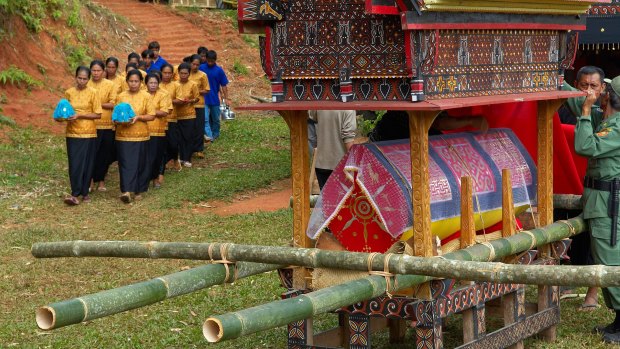This was published 8 years ago
The dying arts of the Toraja
The Toraja people have unique and complex funeral rituals that are hundreds of years old.
By Elspeth Callender

The funeral ceremonies of the Toraja people are ancient and intricate. Indonesia, Sulawesi (Celebes Island), Tana Toraja.Credit: Alamy
If travel is about seeking out different ways of life in order to reflect on our own, the regency of Tana Toraja is a place of curiosities and sideshow mirrors. In the Indonesian province of South Sulawesi, an indigenous ethnic group's cliff-hanging coffins, walking corpses, gesturing effigies and buffalo sacrifices draw local and international tourists into its scenic highlands like teenagers to a zombie flick.
Although Dutch missionaries ostensibly converted the Toraja to Christianity back in the early 1900s, ancient funeral rituals were never lost. Said to be the most complex in the world, they also seem to be among the most expensive – relative, at least, to the local cost of living.
Before our ship docks for the only overnight shore excursion of the cruise, someone gives a lecture. I learn that when the Toraja die, the body is embalmed and stored within the traditional house of relatives, called a tongkonan, and the deceased is symbolically treated as a sick or sleepy family member until enough money is raised for the funeral. Which could take years. After that the body is annually exhumed as part of the Ceremony of Cleaning Corpses involving exactly what the name suggests along with a well-supported stroll through the village. It makes me realise how comparatively stuffy my own culture is about dead bodies.
The name Toraja means people of the uplands so Tana Toraja translates as "the land of the people of the uplands". Several coaches, almost too large for the narrow winding route into the highlands, collect us from the dock at Pare Pare and transport us over several hours to where nearly half a million Toraja reside. Our guide is hugely enthusiastic, shouting his spiel into the coach's PA system with the reverb turned up like the beginning of Prince's Let's Go Crazy.
Misiliana Hotel, our accommodation on the outskirts of the area's cultural centre of Rantepao, really turns it on that evening. The open-air dining room looks decked out for a wedding and there's a buffet, local dance and instrumental performances, karaoke and then a general invitation to shake it. Passengers are assigned to spacious hotel rooms while I sleep in a converted tongkonan because I'm the only one willing to open a door with my head.
The following day begins with a tour of the bullock market. For those who weren't listening in the lecture, this could seem little more than an exercise in keeping shoes clean and breakfast down, but these animals are highly significant to the Toraja. The cost of a good buffalo is outrageous; we're told people work hard and sometimes save for a lifetime in order to publicly slaughter a multitude of high-end beasts, along with some pigs and chickens, at the start of a funeral to display, or possibly determine, the family's social status.
After a series of ceremonies, interment finally takes place on the eleventh day. We leave the market and head to other parts of Tana Toraja to see these burial sites. At villages such as Londa and Lemo, coffins are stored within cliff caves, other coffins hang from cliff faces and we're often overlooked by rows of clay or wooden effigies, known as tau tau, that physically resemble some of the more elite deceased. Only after all funeral ceremonies are over is a person considered entirely dead.
We then visit the settlement of Kete Kesu, believed to be over 400 years old. Rice-barns and tongkonan, with roofs reminiscent of boat hulls, are laid out in the traditional face-to-face configuration alongside fluorescent green rice paddies. Bullock horns of varying sizes adorn tongkonan as symbols of that family's standing and we too can climb a ladder and look inside the cool, dimly lit interior of one. According to the ancient Toraja belief system, both the body and spirit of a person must return home after death. In the past, if a person died while on a journey, family members would literally walk the corpse back to the village. As such, fear of dying on the road and not being able to get home often deterred people from travelling.
Tana Toraja is as touristy as it is fascinating so I find it hard to emotionally connect despite my interest. Yet, back on board the ship that evening, the noise level is significantly higher than usual with passengers all abuzz from the change of scenery, an evening of cutting loose together and exposure to such extraordinary difference. Or perhaps everyone's just pleased to be alive and unafraid to travel lest their wandering spirit can't make it home.
CRUISING THERE
APT owns and operates three small ships for expedition-style trips in Asia, Northern Europe and the Kimberley. Fares for this Seven Seas Odyssey, which will be called 17-day South East Asia Adventure in 2016, are from $11,995 per person, twin share. Phone 1300 196 420; see aptouring.com.au.
Elspeth Callender travelled courtesy of APT.
Sign up for the Traveller Deals newsletter
Get exclusive travel deals delivered straight to your inbox. Sign up now.